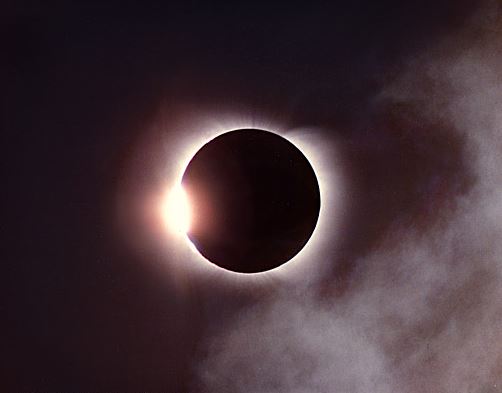I Swallowed a Moon Made of Iron; for, i promise to burn brightly
Andrea Crespo, Loie Hollowell, Andrés Laracuente, and materials from the Wendy Carlos archive
curated by Alan Longino
February 13 - March 29, 2015
Opening: Friday, February 13, 7-10pm
Performance by Marissa Perel: Friday, March 20, 8pm
Drawer 13:
You know I really
like pedestrian sensation.
I like the moon.
It is my favorite image in basically
all of poetry. It makes me sparse
and forget the papers. I like
to fell unfeathered like a first
person pronoun when it first
encounters fabulous
things and this
is what the moon
and the papers
at first both
make me feel.
Forget the buildings and forget
my itching skin
and please also
forget the creepy angelology
of myself as a Renaissance Man.
-Amalia Scott
"Mark of the Beast that Makes History"
On a 15th century desco da parto*, Paolo Schiavo depicts Actaeon in Kristeva’s blue – indeed, the same blue used by Giotto’s some 103 years prior. It is a color that vibrates from the darkness at the peripheries of the eyes’ serrated margins, the first part of the eye to develop, before the fovea brings objects to phenomenal recognition and puts the person, the being, in a central position. Actaeon enters and flees at the margins and is transformed; Diana remains in the center. She is centered as she bathes with her huntresses, that wine-dark fluid surrounding their bodies at the level of the women’s hips, all occupying the inner mandorla of the bath.
♥ ~~~~~~~~~~~~ ♥
[Opening Scene: An A/O Universe, where Alphas are basically futas and Omegas of both sexes can become pregnant. An alpha Madoka appears at the bedside of a fatigued Akemi Homura, who suffers from dire injuries taken from an earlier witch battle. Outside the window it is the crepuscule and Akemi-san takes the hand of Kaname Madoka. Kaname-san lays down her longbow and quiver, and kneels to the level of Akemi-san.]
. . . In hushed tongue . . .
Akemi Homura speaking together with Kaname Madoka
– Do you remember, Mother?
♥ ~~~~~~~~~~~~ ♥
To you, for the show:
Plato’s erotic writings of man to sun, woman to earth, and androgyne to moon, are parsed to platonic solids of the body.
SecondSkin deadens material sound.
Solar eclipses, in intense study and hobby from the 1960s to 2007, ideate the overlapping ovum.
The identities and hormones of Avalokitesvara and Water Moon Kuan-yin multiply and vibrate across geography.
Jean-Luc Nancy talks of drawing and tracing as the moon’s promenade, bringing previously realized form in the act of wax and wane, to find, and in order to find, to seek a form to come.
*birthing platters commissioned to celebrate the survival of mother and child in medieval Tuscany
Wendy Carlos (b. 1939 in Pawtucket, RI. Lives and works in New York City) is an American composer and electronic musician, most notable for her work Switched-On Bach (1968) and her compositional scores for A Clockwork Orange (1971), The Shining (1980), and Tron (1982). She has won both Grammy awards and a Platinum record for Switched-On Bach. Since 1963, Carlos traveled to and photographed solar eclipses, with the most recent photographs in this series dating to 2007. In 1987, Science and Telescope published her image of a solar eclipse as she made history by photographing one of the most difficult parts of a Totality – that of the inner corona, a shot she developed by techniques in the dark room. The works included in this exhibition span from 1968 to 1999, and are respectfully reproduced from her online archive for the purposes of the current presentation. They are accompanied by her text and recounts, which, along with the photographs, are being shown for educational and historical purposes.
Andrea Crespo (b. 1993 in Miami, FL. Lives and works in Brooklyn) is an artist studying at Pratt Institute, currently working on her final, undergraduate semester thesis. She works with collage, sculpture and drawing, as well as online through different sub communities; often these projects taking the form of online exhibitions.Her ongoing project, sis, combines drawing and digital collage techniques within DIDs and multiple personality communities along with their associated medical or psychological prescriptions. Recent exhibitions include The Pain Quotidian, curated by Nick Irvin at HQHQ Project Space, Portland; and Heathers, curated by Alex Ross at Rowing, London. In 2015, she will present a solo exhibition, sis system, at Kraupa-Tuskany Ziedler, Berlin.
Loie Hollowell (b. 1983, Woodland, CA. Lives and works in Queens) is a painter working in early Modernist forms involving loose, platonic expressions of geometry and renderings of the body. In her work, color and composition is influenced equally by O’Keeffe and Dove, but, in subject and display, relates more closely to the body’s organs and sensualities. She graduated with an MFA from Virginia Commonwealth in 2012, and her recent exhibitions include Feelin’ the Dream at Space676, Queens, and Ten Years Too Late, curated by Caetlynn Booth and Tyson Washburn at Institut fur Alles Mogliche, Berlin.
Andrés Laracuente (b. 1982. Lives and works in New York) works primarily with sculpture, performance, and the moving image, and has presented works in New York at The Shandaken Project, White Box, Light Industry, MoMA P.S. 1, and Cleopatra’s. His work tests, or constricts, the extra-haptic responses of material (i.e. the deadening of sound made by sheet metal), and looks to the transitions enacted upon those materials. He has been a visiting artist at Cornell College of Art and Yale School of Art, and a panelist at the MIT 5, moderated by Bill Arning. Laracuente is currently an MFA candidate at Hunter College. He will present his final thesis in Spring 2015.
Lewis Longino (b. 1987, Biloxi, MS. Lives and works in Brooklyn) is an art historian, currently studying as an MA candidate at Hunter College. Recent curatorial projects include, Dialogue Between a Head of Moss and Bloom of Magnolia; we are not facebook friends and we both think that’s cool at 205 Hudson, NY, and These Arabesques at Associated Gallery, NY. His research focuses on Ottoman architecture.


























